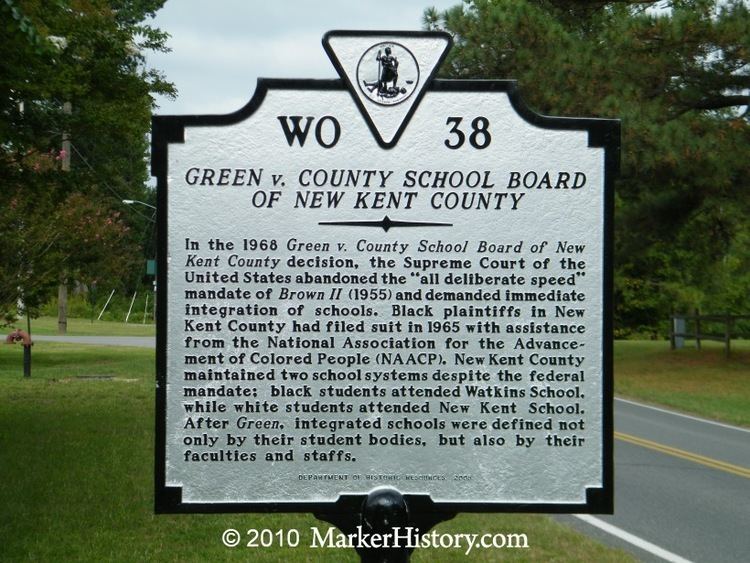End date 1968 | ||
 | ||
Citations 391 U.S. 430 (more)88 S.Ct. 1689, 20 L.Ed.2d 716 Prior history 382 F.2d 338 (4th Cir. 1967), cert. granted, 389 U.S. 1003. Majority Brennan, joined by unanimous Similar Swann v Charlotte‑Mecklenburg Board of, Milliken v Bradley, Cooper v Aaron, Parents Involved in Communi, Davis v County School B | ||
Green v. County School Board of New Kent County, 391 U.S. 430 (1968) was an important United States Supreme Court case dealing with the freedom of choice plans created to avoid compliance with the Court's mandate in Brown II. The Court held that New Kent County's freedom of choice plan did not constitute adequate compliance with the school board's responsibility to determine a system of admission to public schools on a non-racial basis. The Supreme Court mandated that the school board must formulate new plans and steps towards realistically converting to a desegregated system.
Contents
Legal background
In Brown v. Board of Education in 1954, the Warren Court ruled that state-sanctioned segregation of public schools was unconstitutional. One year later, in Brown II, enforcement of this principle was given to district courts, ordering that they take the necessary steps to make admittance to public schools nondiscriminatory "with all deliberate speed." The term "all deliberate speed" did little to speed up the school board's plan for integration. Judge John J. Parker of the United States Court of Appeals for the 4th Circuit led many in the South in interpreting Brown as a charge to not-segregate, but not an order to integrate. The Supreme Court heard several more cases surrounding the speed and efficacy of desegregation between its initial ruling in Brown and the Green v. School Board case in 1968.
Factual background
New Kent is a rural county in eastern Virginia. At the time of the 1960 census, approximately half of the county's 4,500 residents were black. The school system had only two schools, the New Kent School for white students and the George W. Watkins School for black students. School buses traveled overlapping routes throughout the county. The state had long mandated racial segregation in public education under the Virginia Constitution of 1902. The school board continued to operate a segregated system in the wake of the Brown rulings, on the authority of several "massive resistance" state laws enacted to resist them.
One such law, the Pupil Placement Act, divested local boards of authority to assign children to particular schools and centralized that power with the newly-created State Pupil Placement Board. Under the act, children were automatically reassigned to their prior school each year unless they applied for transfer to another school and the board approved their application. New students' schools were also assigned by the board. White families almost uniformly chose the predominantly white school, and black families almost uniformly chose the predominantly black school. As of September 1964, no New Kent student had applied to the Pupil Placement Board for a transfer between the schools.
In 1965, thirty-five black students enrolled in the previously all-white New Kent school. More than a hundred additional black students enrolled each year in 1966 and 1967. The newly enrolled black students reported harassment by their white peers, to which teachers and administrators turned a blind eye.
Green before the Supreme Court
This case was argued during the same term as Raney v. Board of Education of Gould School District and Monroe v. Board of Commissioners of Jackson, Tenn. In the latter case, the plan in question was called "free transfer."
NAACP lawyers Samuel W. Tucker, Henry L. Marsh, III, and Oliver W. Hill prepared the petitioners' case, and Tucker presented their arguments. Frederick T. Gray represented the school board, and Louis F. Claiborne served as amicus curiae. While the Court did not rule that all "freedom of choice" plans were unconstitutional, it did note that they tended to be ineffective at desegregating a school system and held that in New Kent County's case the freedom-of-choice plan violated the Constitution.
The schools after Green
In order to comply with the Court's mandate, the school board separated the New Kent and George Watkins schools by grade level, rather than race. The Watkins School became George W. Watkins Elementary School, and New Kent became New Kent High School.
